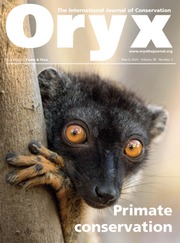Following the publication of our article (Olson et al., Reference Olson, Shen, Matzinger, Solano-Mora, Saborío-R. and Azofeifa2025a), we noticed an error in the identification of individual jaguars observed in our study. We made an assumption early during our study that resulted in two jaguars (Piro, mislabeled as Dani in the originally published article, and El Hijo) being assigned the same identity (left and right profiles, respectively). This error subsequently resulted in another jaguar (Tortugo) being incorrectly labelled as a new individual, although it was in fact the left profile of El Hijo. The error thus affected the detection histories of three individual jaguars. After confirming all other jaguar identities and correcting this error, we reran all analyses that relied on individual jaguar identities.
The results (including those reported in the text, Figs 2–5, Table 2 and the supplementary materials) have subsequently been corrected in the published article; here we provide an overview of how the original error and subsequent correction changed some details of the results. The reduction of one male jaguar resulted in changes to the overall number of jaguars (reduced by one), sex ratios (females:males increased slightly, +0.02), and the mean minimum years alive for males (increased slightly, +0.75; Table 2). It also changed the number of male jaguars determined to be resident (reduced by one), transient (increased by one) or undetermined (reduced by one) and the percentage of activity centres contained within Corcovado National Park for a subset of jaguars (increased slightly for most, but especially for El Hijo and Piro). The correction resulted in a more significant and robust positive relationship between the minimum number of jaguars known alive and the year (Fig. 2c). Corrected jaguar density estimates were slightly lower and appeared to level off in the last 2 years of the dataset (Fig. 3). Forecasted jaguar density estimates under two scenarios exhibited similar results but with slightly reduced modal density estimates compared to the prior estimates (Supplementary Fig. 2). Annual recruitment was reduced slightly, and annual survival rate remained relatively unchanged (Fig. 4). The correction resulted in slightly less variation in the distributions of jaguar density over time (Fig. 5) and substantially less variation in the distributions of individual jaguar activity, mainly for the two affected jaguars (El Hijo and Piro; Supplementary Fig. 1).
Notably, we have since extended this analysis to include data through 2023 (Olson et al., Reference Olson, Shen, Azofeifa, Solano-Mora, Smith and Crabbs2025b), and jaguar density appeared to increase in 2022 and then reduce slightly in 2023 to levels similar to those in 2020 and 2021. That analysis also resulted in annual survival and recruitment rates that were similar to those reported in this correction (Olson et al., Reference Olson, Shen, Azofeifa, Solano-Mora, Smith and Crabbs2025b). Activity centres and jaguar density distribution were also similar, although jaguar density distribution expanded slightly through 2023. We highlight the results of this extension of the analysis through 2023 because it further demonstrates the robustness of the results reported in this correction (and the original article despite the error).
We regret not having detected this error prior to the original publication and thank the publisher for correcting the article to ensure that the correct results are available to readers, and that conservation decision-making is based on the most accurate data available. Although our results changed subtly as a result of this correction, the overall conclusions of our study did not. Our prior conclusion that ‘jaguars in Corcovado National Park may not be in a state of crisis’ is further validated by this corrected analysis. The corrected analysis still ‘…indicate[s] a relatively healthy and growing population’, with growth over time, high survival rates and positive recruitment rates. We reiterate that our findings provide hope for the jaguars of Corcovado National Park, and that this hope does not diminish, but rather reinforce, the importance of continued conservation efforts within and outside the Park.
To ensure transparency and preserve the integrity of the scientific record, the originally published versions of the article and supplementary materials are available in the supplementary material at doi.org/10.1017/S0030605324001170.


